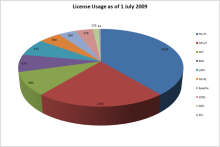Codeplex the measure of Microsoft open source street cred


I agree that CodePlex is a fair way to measure the credibility Microsoft has with open source developers, or its "street cred."
But one can also have different views on the same numbers.
For example, as my friend Roberto Galopppini noted yesterday, Google has become home to 80,000 projects in half the time CodePlex has been open. Numbers don't just live in abstract isolation. They can be compared, apples-to-apples, and so Google's street cred looks pretty good.
It can also be useful to look at Microsoft's own statistics and ask, how mainstream is CodePlex? The picture above, from Microsoft, tells that story.
It's a pie chart showing the popularity of various licenses within CodePlex. The big wedge of blue represents the share held by Microsoft's MS-PL license, and it's about 36% of the total. The smaller red wedge below it is the share of GPLv2, about 20%. The light blue wedge to the left is the share held by LGPL, about 6.7%.
This is interesting. A fifth of the projects at Microsoft's own CodePlex site are GPLv2. But compare that to the general market, as Black Duck did recently (however accurately). In the general market 65% of projects are GPLv2, and that's somewhat down recently in part because of the efforts at CodePlex.
In other words, the CodePlex audience is still skewed toward Microsoft licenses, and is far from representative of the whole open source movement.
Why does this matter? Let's use a political analogy. The same arguments are used against any small political movement, the idea that it's unrepresentative of the people as a whole. Whether you're talking about Howard Dean on the left or the Ron Paul troops on the right, such statistics are proof you're out of the mainstream.
If Microsoft is evolving toward being an "open core" open source supplier, with open code at the center and proprietary extensions, that evolution still has far to go.
But it has begun. The Microsoft teabag has hit the water. How big a splash it makes has yet to be determined.